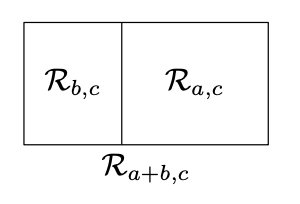20.5: Area of solid rectangles
- Page ID
- 23714
\( \newcommand{\vecs}[1]{\overset { \scriptstyle \rightharpoonup} {\mathbf{#1}} } \)
\( \newcommand{\vecd}[1]{\overset{-\!-\!\rightharpoonup}{\vphantom{a}\smash {#1}}} \)
\( \newcommand{\dsum}{\displaystyle\sum\limits} \)
\( \newcommand{\dint}{\displaystyle\int\limits} \)
\( \newcommand{\dlim}{\displaystyle\lim\limits} \)
\( \newcommand{\id}{\mathrm{id}}\) \( \newcommand{\Span}{\mathrm{span}}\)
( \newcommand{\kernel}{\mathrm{null}\,}\) \( \newcommand{\range}{\mathrm{range}\,}\)
\( \newcommand{\RealPart}{\mathrm{Re}}\) \( \newcommand{\ImaginaryPart}{\mathrm{Im}}\)
\( \newcommand{\Argument}{\mathrm{Arg}}\) \( \newcommand{\norm}[1]{\| #1 \|}\)
\( \newcommand{\inner}[2]{\langle #1, #2 \rangle}\)
\( \newcommand{\Span}{\mathrm{span}}\)
\( \newcommand{\id}{\mathrm{id}}\)
\( \newcommand{\Span}{\mathrm{span}}\)
\( \newcommand{\kernel}{\mathrm{null}\,}\)
\( \newcommand{\range}{\mathrm{range}\,}\)
\( \newcommand{\RealPart}{\mathrm{Re}}\)
\( \newcommand{\ImaginaryPart}{\mathrm{Im}}\)
\( \newcommand{\Argument}{\mathrm{Arg}}\)
\( \newcommand{\norm}[1]{\| #1 \|}\)
\( \newcommand{\inner}[2]{\langle #1, #2 \rangle}\)
\( \newcommand{\Span}{\mathrm{span}}\) \( \newcommand{\AA}{\unicode[.8,0]{x212B}}\)
\( \newcommand{\vectorA}[1]{\vec{#1}} % arrow\)
\( \newcommand{\vectorAt}[1]{\vec{\text{#1}}} % arrow\)
\( \newcommand{\vectorB}[1]{\overset { \scriptstyle \rightharpoonup} {\mathbf{#1}} } \)
\( \newcommand{\vectorC}[1]{\textbf{#1}} \)
\( \newcommand{\vectorD}[1]{\overrightarrow{#1}} \)
\( \newcommand{\vectorDt}[1]{\overrightarrow{\text{#1}}} \)
\( \newcommand{\vectE}[1]{\overset{-\!-\!\rightharpoonup}{\vphantom{a}\smash{\mathbf {#1}}}} \)
\( \newcommand{\vecs}[1]{\overset { \scriptstyle \rightharpoonup} {\mathbf{#1}} } \)
\( \newcommand{\vecd}[1]{\overset{-\!-\!\rightharpoonup}{\vphantom{a}\smash {#1}}} \)
\(\newcommand{\avec}{\mathbf a}\) \(\newcommand{\bvec}{\mathbf b}\) \(\newcommand{\cvec}{\mathbf c}\) \(\newcommand{\dvec}{\mathbf d}\) \(\newcommand{\dtil}{\widetilde{\mathbf d}}\) \(\newcommand{\evec}{\mathbf e}\) \(\newcommand{\fvec}{\mathbf f}\) \(\newcommand{\nvec}{\mathbf n}\) \(\newcommand{\pvec}{\mathbf p}\) \(\newcommand{\qvec}{\mathbf q}\) \(\newcommand{\svec}{\mathbf s}\) \(\newcommand{\tvec}{\mathbf t}\) \(\newcommand{\uvec}{\mathbf u}\) \(\newcommand{\vvec}{\mathbf v}\) \(\newcommand{\wvec}{\mathbf w}\) \(\newcommand{\xvec}{\mathbf x}\) \(\newcommand{\yvec}{\mathbf y}\) \(\newcommand{\zvec}{\mathbf z}\) \(\newcommand{\rvec}{\mathbf r}\) \(\newcommand{\mvec}{\mathbf m}\) \(\newcommand{\zerovec}{\mathbf 0}\) \(\newcommand{\onevec}{\mathbf 1}\) \(\newcommand{\real}{\mathbb R}\) \(\newcommand{\twovec}[2]{\left[\begin{array}{r}#1 \\ #2 \end{array}\right]}\) \(\newcommand{\ctwovec}[2]{\left[\begin{array}{c}#1 \\ #2 \end{array}\right]}\) \(\newcommand{\threevec}[3]{\left[\begin{array}{r}#1 \\ #2 \\ #3 \end{array}\right]}\) \(\newcommand{\cthreevec}[3]{\left[\begin{array}{c}#1 \\ #2 \\ #3 \end{array}\right]}\) \(\newcommand{\fourvec}[4]{\left[\begin{array}{r}#1 \\ #2 \\ #3 \\ #4 \end{array}\right]}\) \(\newcommand{\cfourvec}[4]{\left[\begin{array}{c}#1 \\ #2 \\ #3 \\ #4 \end{array}\right]}\) \(\newcommand{\fivevec}[5]{\left[\begin{array}{r}#1 \\ #2 \\ #3 \\ #4 \\ #5 \\ \end{array}\right]}\) \(\newcommand{\cfivevec}[5]{\left[\begin{array}{c}#1 \\ #2 \\ #3 \\ #4 \\ #5 \\ \end{array}\right]}\) \(\newcommand{\mattwo}[4]{\left[\begin{array}{rr}#1 \amp #2 \\ #3 \amp #4 \\ \end{array}\right]}\) \(\newcommand{\laspan}[1]{\text{Span}\{#1\}}\) \(\newcommand{\bcal}{\cal B}\) \(\newcommand{\ccal}{\cal C}\) \(\newcommand{\scal}{\cal S}\) \(\newcommand{\wcal}{\cal W}\) \(\newcommand{\ecal}{\cal E}\) \(\newcommand{\coords}[2]{\left\{#1\right\}_{#2}}\) \(\newcommand{\gray}[1]{\color{gray}{#1}}\) \(\newcommand{\lgray}[1]{\color{lightgray}{#1}}\) \(\newcommand{\rank}{\operatorname{rank}}\) \(\newcommand{\row}{\text{Row}}\) \(\newcommand{\col}{\text{Col}}\) \(\renewcommand{\row}{\text{Row}}\) \(\newcommand{\nul}{\text{Nul}}\) \(\newcommand{\var}{\text{Var}}\) \(\newcommand{\corr}{\text{corr}}\) \(\newcommand{\len}[1]{\left|#1\right|}\) \(\newcommand{\bbar}{\overline{\bvec}}\) \(\newcommand{\bhat}{\widehat{\bvec}}\) \(\newcommand{\bperp}{\bvec^\perp}\) \(\newcommand{\xhat}{\widehat{\xvec}}\) \(\newcommand{\vhat}{\widehat{\vvec}}\) \(\newcommand{\uhat}{\widehat{\uvec}}\) \(\newcommand{\what}{\widehat{\wvec}}\) \(\newcommand{\Sighat}{\widehat{\Sigma}}\) \(\newcommand{\lt}{<}\) \(\newcommand{\gt}{>}\) \(\newcommand{\amp}{&}\) \(\definecolor{fillinmathshade}{gray}{0.9}\)A solid rectangle with sides \(a\) and \(b\) has area \(a\cdot b\).
- Proof
-
Suppose that \(\mathcal{R}_{a,b}\) denotes the solid rectangle with sides \(a\) and \(b\). Set
\(s(a,b)=\text{area } \mathcal{R}_{a,b}.\)
By definition of area, \(s(1,1)=\text{area }(\mathcal{K})=1\). That is, the first identity in the algebraic lemma holds.

Note that the rectangle \(\mathcal{R}_{a+b,c}\) can be subdivided into two rectangle congruent to \(\mathcal{R}_{a,c}\) and \(\mathcal{R}_{b,c}\). Therefore, by Proposition 20.4.2,
\(\text{area }\mathcal{R}_{a+b,c}=\text{area } \mathcal{R}_{a,c}+\text{area } \mathcal{R}_{b,c}\)
That is, the second identity in the algebraic lemma holds. The proof of the third identity is analogues.
It remains to apply the algebraic lemma.
Assume that a function \(s\) returns a nonnegative real number \(s(a,b)\) for any pair of positive real numbers \((a,b)\) and it satisfies the following identities:
\(\begin{aligned} s(1,1)&=1; \\ s(a,b+c)&=s(a,b)+s(a,c) \\ s(a+b,c)&=s(a,c)+s(b,c)\end{aligned}\)
for any \(a,b,c>0\). Then
\(s(a,b)=a\cdot b\)
for any \(a,b>0\).
The proof is similar to the proof of Lemma 14.4.1.
- Proof
-
Note that if \(a>a'\) and \(b>b'\) then
\[s(a,b)\ge s(a',b').\]
Indeed, since \(s\) returns nonnegative numbers, we get that
\(\begin{aligned} s(a,b)&=s(a',b)+s(a-a',b)\ge \\ &\ge s(a',b)= \\ &\ge s(a',b')+s(a',b-b')\ge \\ &\ge s(a',b').\end{aligned}\)
Applying the second and third identity few times we get that
\(\begin{aligned} s(a,m\cdot b)=s(m\cdot a,b)=m\cdot s(a,b)\end{aligned}\)
for any positive integer \(m\). Therefore
\(\begin{aligned} s(\tfrac kl,\tfrac mn)&=k \cdot s(\tfrac 1l,\tfrac mn)= \\ &=k\cdot m \cdot s(\tfrac 1l,\tfrac 1n)= \\ &=k\cdot m\cdot \tfrac 1l\cdot s(1, \tfrac 1n)= \\ &=k\cdot m\cdot \tfrac 1l\cdot \tfrac 1n\cdot s(1,1)= \\ &=\tfrac kl\cdot\tfrac mn\end{aligned}\)
for any positive integers \(k\), \(l\), \(m\), and \(n\). That is, the needed identity holds for any pair of rational numbers \(a=\tfrac kl\) and \(b=\tfrac mn\).
Arguing by contradiction, assume \(s(a,b)\ne a\cdot b\) for some pair of positive real numbers \((a,b)\). We will consider two cases: \(s(a,b)> a\cdot b\) and \(s(a,b)< a\cdot b\).
If \(s(a,b)> a\cdot b\), we can choose a positive integer \(n\) such that
\[s(a,b)> (a+\tfrac1n)\cdot (b+\tfrac1n).\]
Set \(k=\lfloor a\cdot n \rfloor+1\) and \(m=\lfloor b\cdot n \rfloor+1\); equivalently, \(k\) and \(m\) are positive integers such that
\(a< \tfrac kn\le a+\tfrac1n \quad\text{and}\quad b<\tfrac mn\le b+\tfrac1n.\)
By 20.5.1, we get that
\(\begin{aligned} s(a,b)&\le s(\tfrac kn,\tfrac mn)= \\ &=\tfrac kn\cdot\tfrac mn\le \\ &\le (a+\tfrac1n)\cdot(b+\tfrac1n),\end{aligned}\)
which contradicts 20.5.2.
The case \(s(a,b)< a\cdot b\) is similar. Fix a positive integer \(n\) such that \(a>\tfrac1n\), \(b>\tfrac1n\), and
\[s(a,b)< (a-\tfrac1n)\cdot (b-\tfrac1n).\]
Set \(k=\lceil a\cdot n \rceil-1\) and \(m=\lceil b\cdot n \rceil-1\); that is,
\(a> \tfrac kn\ge a-\tfrac1n \quad\text{and}\quad b>\tfrac mn\ge b-\tfrac1n.\)
Applying 20.5.1 again, we get that
\(\begin{aligned} s(a,b)&\ge s(\tfrac kn,\tfrac mn)= \\ &=\tfrac kn\cdot\tfrac mn\ge \\ &\ge (a-\tfrac1n)\cdot(b-\tfrac1n),\end{aligned}\)
which contradicts 20.5.3.


